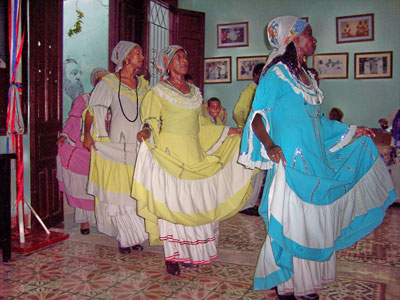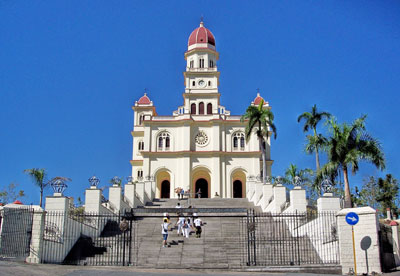Santiago de Cuba awakenings
This item appears on page 62 of the January 2014 issue.
(3rd of 3 parts on Cuba)
Our group was traversing the heavily forested mountains of the Baracoa region in eastern Cuba via La Farola, a 2-lane highway completed in 1965 by the Castro government. At that time, the roadway was a much-heralded triumph of the Cuban Revolution because it finally connected isolated Baracoa, formerly accessible only by sea, with Santiago de Cuba and the rest of Cuba.
This road trip was the beginning of the third and final leg of my spring 2013, 12-day hosted adventure to Havana and eastern Cuba as part of a group of nine explorers traveling with the Grand Circle Foundation. We would be spending our final four days based in the island’s second-largest city, Santiago de Cuba, generally referred to as Santiago (pop. 400,000).
Santiago revelations
Our first stop upon arrival in Santiago was the top of San Juan Hill. There our guide brought to life the 1898 Spanish-American War exploits of Teddy Roosevelt and the Rough Riders. I had not realized the famous battle resulted in such a bloodbath for the victorious American contingent.
From this elevated viewpoint, I began to notice stark evidence of the severe devastation inflicted upon Santiago from its direct-path encounter with Hurricane Sandy in October 2012.
A few days later, our group visited with several homeowners working on the restoration of their hurricane-damaged houses across the road from the Moncada Barracks. This was the site of the 1953 armed assault against government troops that was led by Fidel Castro and which is credited with launching the Cuban Revolution.
Santiago touring whirlwind
Our Santiago de Cuba schedule, like those in both Havana and Baracoa, featured a barrage of daily cultural interactions with Cubans in a wide range of settings.
On foot in the historic city center, we explored the maze of narrow streets in and around Parque Céspedes, one of the liveliest squares in Cuba. It is not only a place for socializing but boasts important architectural and cultural sites. These include Governor Diego Velázquez’s house (constructed between 1516 and 1530), an imposing cathedral and the residence of the renowned 19th-century Cuban poet José María Heredia.
Our focus was on Calle Heredia, Santiago’s most famous and festive street, where all homes and businesses bear signs that celebrate the city’s great passion for music, dancing and the Santiago Carnaval.
Many popular restaurants are located along Heredia. Overlooking Céspedes Square, some of us enjoyed lunch on the elevated balcony of the historic Hotel Casa Granda, an excellent location from which to observe the midday sea of locals continuously flowing in all directions.
Touring diversity
In Santiago, our visitations included huge Santa Ifigenia Cemetery, where many important Cuban luminaries have been laid to rest. On site, we observed the austere changing of the guard at the mausoleum of 19th-century Cuban hero José Martí.
A tour of a sparsely appointed senior center included our being serenaded as well as singing and playing dominoes with the gracious residents. Also, we met with two award-winning painters, learning about the challenges they face today in making a living through their art. Later, an advisory revealed that successful artists are near the top end of the Cuban economic scale.
In the city, we also were the beneficiaries of an illuminating discussion of regional Afro-Cuban religious beliefs and traditions. Among these is Santería, whose roots trace back to West Africa, from which ships transported thousands of captured slaves to Santiago between the late 18th and early 19th centuries to provide a source of labor for the burgeoning sugar plantations of eastern Cuba.
Performing arts take center stage
Spotlighting Santiago’s performing arts, we visited the Ballet Folklórico de Oriente dance company and were entranced by a pulsating, West Africa-influenced performance by the Tumba Francesa cultural troupe.
Another day, our group was inspired by a very talented children’s dance group which, at the end of their performance, insisted we dance with them.
Talent in the performing arts runs very deep in Cuba, especially in Santiago, and seems to be part of the national DNA. This may be a positive byproduct of several generations of Cubans living their entire lives with limited access to either American or European television, movies, cell phone apps or the Internet.
The resulting innocence of the Cuban children was reminiscent of life 60 years ago in the US. It was perhaps the best example of “less is more” positive modeling that I have encountered.
Farther afield
One morning we ventured outside the city to visit Cuba’s most famous and perhaps most beautiful church, Basílica del Cobre, whose black Madonna is considered by most Cubans to be the country’s protectress. This holy shrine is a famous pilgrimage site for legions of faithful from all over Cuba.
Later the same day, on a small island in the Bay of Santiago, our group met with four local fishermen and gained insight into the economic challenges — and joys — of their daily lives.
When I presented each of them with a Leatherman-style multipurpose tool, their smiles and overt expressions of gratitude were humbling. Our exchange was followed by a guided walk around the compact residential island, where we observed more hurricane damage.
We then embarked on a cooling bay cruise, which included upward views of towering Castillo del Morro, constructed in stages between 1638 and 1700 to guard the entrance to the bay. Our return the following day to tour this impressive, blufftop fortress, a UNESCO World Heritage Site, provided sweeping views of the coastline and bay far below.
Béisbol, anyone?
On our final afternoon, I asked to be dropped off at the baseball stadium, home of the local Santiago professional team. Even though I had thrown in the towel regarding my goal of seeing a professional game while in Cuba, I was seeking a consolation prize in the form of an authentic baseball cap for the team. Imagine my surprise and excitement to find a game in progress!
Three convertible pesos (almost always referred to as CUCs) later, I was nestled into my seat in the first row behind home plate, where I enjoyed three innings of action and purchased a cap directly from the Santiago team’s dugout before departing the stadium a most happy camper.
Managing the music equation
Cuba, unfailingly, is synonymous with music. At virtually all restaurant meals during our journey, local musicians were performing, and, in all cases, they offered CDs of their music for sale to diners. Everywhere we went in Cuba, these CDs each cost CUC10, an amount commonly referred to as a “pescado” and equal to $10.
Since the novelty of acquiring a Cuban music CD will typically wear off about two days into a trip, what should you do after that when the performers come around in CD-selling mode? Many in our group used roughly the following strategy.
If you want the CD for yourself or as a gift, buy it. If you enjoyed the music but don’t want the CD, give the performers a few pesos as a tip, if so inclined. Keep in mind that these musicians typically manage a better income than doctors and other skilled professionals who have no access to tourist revenue.
During this amazing journey in Cuba, our group enjoyed many types of private music performances. These performing groups are paid a fee by the Grand Circle Foundation and typically also will have CDs for sale. The same advisory mentioned above applies, although you may wish to leave larger donations for some groups.
Before you go
For information concerning the “Cuba: Music, Culture & The Roots of Revolution” tour of Havana and eastern Cuba, contact Grand Circle Foundation (347 Congress St., Boston, MA 02210; 800/859-0852).
The bully on the block
The opinions expressed in the following paragraphs are mine alone.
The US government, as of this writing, continues to refuse to allow Americans to travel to Cuba as tourists. This restriction is a longstanding concession to powerful special interest groups that do not want the USA to normalize relations with Cuba. The travel restriction applies to no other country, including threat-provoking sworn enemies of the USA such as North Korea.
To be in compliance with US law, an American wishing to visit Cuba must join a specially licensed group and travel under very strict constraints, including being allowed virtually no free time, as having free time would classify the traveler as a tourist. The other option is to travel illegally to Cuba through a third country, something that thousands of Americans do each year.
The US government, with an embargo that is supported by none of its allies and which works continued hardship on the Cuban people, remains the bully on the block. Additionally, most American companies are prohibited from engaging in business with Cuba.
These governmental restrictions on the freedom of Americans to travel and conduct business violate the spirit of the US Constitution.
Why all this raving and raging on my part in a travel publication? Because I feel this long-outdated policy is wrong at every level. Because our democratic society is supposed to be far better than that.
Americans who believe the current travel restrictions regarding Cuba are an affront to our freedoms and need to end are encouraged to share those sentiments with their congressional representatives.
Beyond the Garden Wall
Where joy is found in simple pleasure,
where rhythm evokes passion
and passion evokes rhyme,
where heart and soul find harmony in the beat of life
— Randy describing the mystique of Cuba
Editor’s note: Regarding the US embargo against Cuba, the following points can be made (reference the Publisher’s note, May 2010, pages 61-62).
When Fidel Castro seized power in Cuba in 1959, he took over US companies, including International Telephone & Telegraph, Sears and some others. The US Department of State has told Cuba on many occasions that if they would pay for the seized properties, the embargo would end. The response has always been negative. The State Department has not asked for any interest to be paid nor for the value of the seized properties in today’s dollars but just for what it was worth in 1959, which comes to about five million dollars.
Food, medicine and agricultural implements are exempted from the US embargo. Cuba does trade with the rest of the world. In addition, tourists have been flocking there from countries worldwide, and now each year thousands of Americans are visiting on regulated educational programs. — DT


